Lea Wait's Blog, page 55
September 22, 2023
To Have an Opinion or to Not Have an Opinion by Matt Cost
It is vitally important to flesh out the characters in a novel. They must leap from the pages vivaciously like real living beings. And nobody is more important than that of the protagonist of the story. Nothing will kill a book quicker than a Flat Stanley character with no depth—physically, emotionally, or mentally.

Langdon, Clay, and 8 Ballo can’t just be PIs perusing the pages pursuing the baddies. Why? Because we, the writer and readers, must care about them. They need a favorite color. Unrealized dreams and heartache. Love, desire, and lust. Pet peeves such as people who don’t know how to use blinker signals.
Unless it is a horror book, nobody cares about a skeleton flittering through the story arc. We all know that those with no names and descriptions are going to be the first to die. To bring the invisible to visible, a character has to be imbued with traits that we associate with humanity, good and bad, and creates a sense of caring.

“I am an invisible man. No, I am not a spook like those who haunted Edgar Allen Poe: Nor am I one of your Hollywood movie ectoplasms. I am a man of substance, of flesh and bone, fiber, and liquids — and I might even be said to possess a mind. I am invisible, simply because people refuse to see me.” — Ralph Ellison, Invisible Man
I trust that everybody agrees with my assessment of the necessity of pumping substance into a character by giving them likes, dislikes, wants, backstory, dreams, and a personality. Why, then, are these characters not allowed to have a political or social opinion?
It does not have to be infused into every page punching the reader in the face, but the reality is that human beings have opinions, and most have strong points of view regarding political and social issues.
My last three books deal with wendigos, gangsters, and cartels striving for world domination. Three things that people can come together against, even if there is a subtle idolization of gangsters throughout history, or, at least, much more than wendigos and evil cartels.
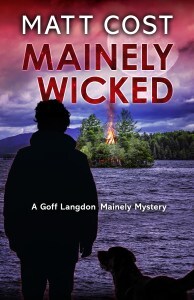
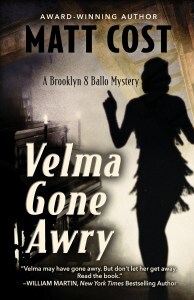

But I have also written a historical fiction castigating the anti-Black equality white supremacist attitude in much of the South after the Civil War. I’ve stepped onto a limb and suggested that in 1959, Fidel Castro was a rock star and a hero the entire world over, especially here in the US. I’ve gone after Big Pharma, cult-like religions, analyzed genome editing, and attacked antivaxxers. Not me, necessarily, but the protagonists of my mysteries. Men and women who have opinions.

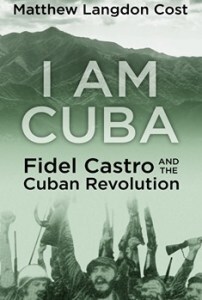

Infusing my people with opinions of a political or social issue has been one of the largest pieces of criticism that I have received. “This was a good book but no reason to be stating a political belief. One Star.” That sort of thing from reviewers who also happen to be haters. And the standard advice I hear is to leave politics and social opinions off the pages.
Of course, this does not pertain to those who have reached fame and fortune in the writing world. Once you reach the top of this artistic field, it seems, you can do whatever you want. But until you reach that plateau, your art is meant to be redacted, so that political and social beliefs are left in the waste basket of editorial despair.
What say you, readers and writers? Should characters, protagonists, antagonists—have political and social opinions or should they remain a Flat Stanley in those particular viewpoints?
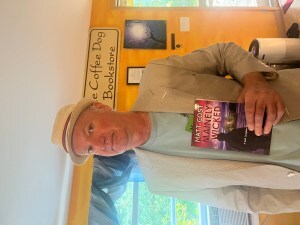
Matt Cost was a history major at Trinity College. He owned a mystery bookstore, a video store, and a gym, before serving a ten-year sentence as a junior high school teacher. In 2014 he was released and began writing. And that’s what he does. He writes histories and mysteries.
Cost has published five books in the Mainely Mystery series, with the fifth, Mainely Wicked, just released in August of 2023. He has also published four books in the Clay Wolfe Trap series, with the fifth, Pirate Trap, due out in December of 2023.
For historical novels, Cost has published At Every Hazard and its sequel, Love in a Time of Hate, as well as I am Cuba. In April of 2023, Cost combined his love of histories and mysteries into a historical PI mystery set in 1923 Brooklyn, Velma Gone Awry. City Gone Askew will follow in April of 2024.
Cost now lives in Brunswick, Maine, with his wife, Harper. There are four grown children: Brittany, Pearson, Miranda, and Ryan. A chocolate Lab and a basset hound round out the mix. He now spends his days at the computer, writing.
September 20, 2023
Owning an Island
You take the Laura B  from Port Clyde, as if you were going out to Monhegan, but five miles out, your captain backs the boat into a tiny wharf off an island named Allen, in a narrow cut between it and Benner Island, dodging some semi-permanent moorings. You’ve arrived at what was once the summer home of Betsy Wyeth, wife of Andrew, daughter-in-law of N.C. Wyeth, and mother of Jamie.
from Port Clyde, as if you were going out to Monhegan, but five miles out, your captain backs the boat into a tiny wharf off an island named Allen, in a narrow cut between it and Benner Island, dodging some semi-permanent moorings. You’ve arrived at what was once the summer home of Betsy Wyeth, wife of Andrew, daughter-in-law of N.C. Wyeth, and mother of Jamie.
 Betsy, who died in 2020 at the age of 98, purchased 500-acre Allen Island in 1979, then Benner in 1990. She spent summers here, sometimes with Andrew, sometimes not.
Betsy, who died in 2020 at the age of 98, purchased 500-acre Allen Island in 1979, then Benner in 1990. She spent summers here, sometimes with Andrew, sometimes not.
Much is made of the fact that the Wyeths were not the “typical” summer people, whatever that means in an age when people work remotely and the season extends from Mother’s Day to Thanksgiving. Betsy did create a lobstering wharf on Allen, which is still in use today. She also expended a great deal of money and effort on restoring the buildings found on the island, creating splendid gardens and pastures, dug freshwater ponds. And she was notoriously protective of her solitude on both Allen and Benner, where she lived. (Not all Betsy’s impulses were pro-preservation. She allegedly built a long straight road the length of Allen so she could drive her Mini from one end to the other.)
The islands were originally “owned” by the Abenaki. A British explorer landed on the island in 1605, and a cross with his name commemorates the site of one of the first Anglican church services in North America. Allen Island supported a vibrant fishing community for many years, until the resident population declined.
In 2022, Colby College acquired the islands.  I got to visit them a couple of months ago, and listen to the college’s Island Fellows talk about their work. Vaults for Andrew’s paintings are now laboratory space for trematode research, and while I’m not completely sure what they are, they’re not as cute as the puffins. Another researcher is cataloguing the soundscapes of the wind and the water. But since the Gulf of Maine is warming so rapidly, Allen Island is a useful place for environmental research.
I got to visit them a couple of months ago, and listen to the college’s Island Fellows talk about their work. Vaults for Andrew’s paintings are now laboratory space for trematode research, and while I’m not completely sure what they are, they’re not as cute as the puffins. Another researcher is cataloguing the soundscapes of the wind and the water. But since the Gulf of Maine is warming so rapidly, Allen Island is a useful place for environmental research.
While I appreciate Betsy’s preservation instincts, something in me quails at the notion that this beautiful land, the views, the harbors, were the sole preserve of one small privileged family for so long. It pleases me that the arc of Allen Island’s history is bending back to a communal respect for its possibilities, not a restrictive ownership. And what makes me struggle a bit less with the notion of private ownership is that you cannot truly own an island, can you? Long after you’re gone, the granite, the trees, the birds, the wind, and the water, abide.
September 19, 2023
Gimme a Ticket for an Aeroplane by Anne Britting Oleson
I just got back from an adventure in the UK, my second this year, all in aid of narrative accuracy.
For the past year or so, I’ve been writing the third installment in the Aventurine Morrow series, Aventurine on the Border. The first part of this book takes place in The Kingdom of Hay, which is a town straddling the border between Wales and England: the River Wye cuts right through the middle of it. Hay is the Used Book Capital of the UK, with bookshops lining the streets, inhabiting the Back Fold near the castle, and with the Honesty Bookshop (where one pays £1 per book into a self-service receptacle) tucked up against the bailey walls; it was declared its own kingdom by the original Hay bookseller, Richard Booth, who became its self-styled king. I’ve visited a number of times, but most recently spent time there in February, which, in the UK, is when the world is waking up from winter: warm breezes, daffodils, and mud–lots of mud. Because my characters need to navigate this town realistically, I did things they would need to do. I bought books. I squelched the public footpaths along the river and through the hills. I found the most wonderful coffee shop, next to the Buttermarket, and bought coffee in one to drink in the other. I wrote in pubs, drinking pints by the half, because I’m a lightweight. I was there on Pancake Day (the day before Lent begins), so the proprietor of the hotel in which I stayed–shoutout to The Swan!–made me pancakes with sugar and lemon. Aventurine made adventures; Anne made memories.


Hay-on-Wye appears in many many books. Lady of Hay by Barbara Erskine is one of the first I read, ages ago, and possibly one of the most famous. It’s the story of a journalist doing hypnotic regression, and finds she may or may not be the reincarnation of Matilda, the Lady of Hay in question; the present, in this novel, is interwoven with the past in a way that’s curious and fascinating. Another book, in the Merrily Watkins series by Phil Rickman–one of my favorite authors–is The Magus of Hay, which has his main character, the deliverance consultant for the Diocese of Hereford (read exorcist) investigating weirdness in Hay. It was Phil who made me want to visit originally, but I will freely admit: the Honesty Bookshop became the main draw for me. When I was there in February, I spent ages trolling the shelves–all in the open air, under a slanting roof to keep off the rain–and bought a number of paperbacks that grabbed my fancy; the £1 charge per book goes to help maintain the castle. In Aventurine on the Border, Avi picks up some books there, as does her twin sister Micheline; those books lead them on a series of adventures which may or may not have something to do with the disappearance, in an earlier book, of Mick’s husband.

The glory of visiting a location like Hay-on-Wye is that it’s a great place to give inspiration to a story. Actually, that’s the glory of visiting nearly every place I’ve ever gone in the UK. I have lots of stories of my adventures there–including blowing out my knee in Whitby this past summer (that’s another story, never mind–to paraphrase the Witch in Into the Woods)–and many of them make their way into my books. Perhaps I’ll tell you another one another time.
Anne Britting Oleson lives and writes on the side of a mountain in central Maine. She has three children, five grandchildren, two cats, and nine books–three poetry chapbooks, and six novels–with a seventh novel due out in September 2023. She is a founding member of Simply Not Done, a women’s reading, writing, and teaching collaborative.When she grows up, she wants to marry all the words.
September 17, 2023
Cooler Surprise. Deer Flies. Acres of Lettuce.
Sandra Neily here: There’s a moment on every camping trip where you peer into the cooler to see what’s left floating around down there. A “Cooler Surprise” meal with a bit of everything often has us thinking over the whole trip’s memorable moments. Both the highs and the lows.

The lilacs were amazing and then the rains came and came and diseases ate my flower boxes.
This post is kind of a cooler surprise: bits of my summer that might not have much to do with each other, but—to me—they are a rich dish of experience to savor … and share.
Books On Tape in the Casita
My husband and I like to hunker down after dark (when the bugs are bad) and listen to audio books inside our tiny camper. C. J. Box opens Savage Run with an exploding cow. (First lines are so very important! For sure.) Then after the cow, while investigating a string of bizarre murders, Wyoming game warden Joe Pickett is forced to flee across treacherous terrain with a brutal tracker on his trail.
In our tight space, dog Raven lying over our feet, we are clearly somewhere in Wyoming, even deep in the Maine woods. We have to force ourselves to stop listening at a reasonable hour.
Dog Songs from Mary Oliver
I found this magical slim volume in my bookshelves and wondered how I’d lost track of it. I sent a copy of it to someone who’d just lost their long-time dog companion and then reread it several times, savoring each simple and fresh way Oliver opens a world we can share.
“Dog Songs . . . is a sweet golden retriever of a book that curls up with the reader.” —The New York Times
“Oliver . . . is one of our most adored poets, and a longtime lover of dogs. The popularity of [Dog Songs] feels as inevitable and welcome as a wagging tail upon homecoming.” —The Boston Globe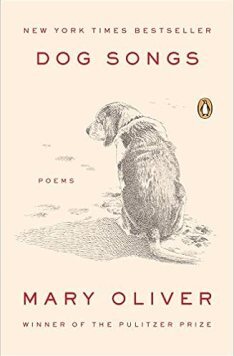
Bits:
“Because of the dog’s joyfulness, our own is increased. It is no small gift. It is not the least reason why we should honor as well as love
the dog of our own life, and the dog down the street, and all the dogs not yet
born. What would the world be like without music or rivers or the green and
tender grass? What would this world be like without dogs?”
“A dog can never tell you what she knows from the
smells of the world, but you know, watching her,
that you know
almost nothing.”

Raven’s first day as our dog; she too cowered at the memory of broom-like objects. Seven years later, she’s much better and happier.
“What shall I do? When I pick up the broom he leaves the room. When I fuss with kindling he runs for the yard. Then he’s back, and we hug for a long time. In his low-to-the-ground chest I can hear his heart slowing down. Then I rub his shoulders and kiss his feet and fondle his long hound ears. Benny, I say, don’t worry. I also know the way the old life haunts the new.”

Bucks Harbor
A Sailing Gift My good friend Leslie gifted me with a windjammer cruise on the Angelique. Covid had me canceling on our group several years ago, but she made sure I would not miss the magic. And it was magic. When we sailed into Bucks Harbor, all of us moms who’d read 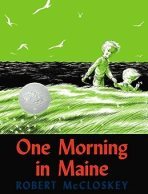 One Morning in Maine multiple times to our children leaned over the rail together and breathed in the harbor. One woman knew the book’s opening lines.
One Morning in Maine multiple times to our children leaned over the rail together and breathed in the harbor. One woman knew the book’s opening lines.
“One morning in Maine, Sal woke up she peeked over the top of the covers, the bright sunlight made her blink, so she pulled the covers up and was just about to go back to sleep when she remembered ‘today is the day I am going to Buck’s Harbor with my father!”


Coltsfoot growing into the stream
Saving The Stream Behind My House I pulled six industrial-sized garbage bags of Coltsfoot from the stream behind my house. Unchecked, it threatened to choke its life. You have to pull each invasive plant out by the roots. That means reaching under rocks and following the plant stem wherever it leads. While it was backbreaking work, it was also a good time to be wet in the stream. August heat was so relentless I often lay down on wet rocks released from the plant’s clutches. (Don’t ignore this nasty invasive; throttle it before it smothers what you care about.)
Grandgirls and Scat
 Both my granddaughters who came to “camp” for a long visit are fascinated by animal poop. Well, so am I. Cries of “it’s gotta be bear. There’s raspberries!” Or “Ohhh, there’s gray hair in here. Did it eat a rabbit?” Armed with rubber gloves and sharp sticks we explore the woods. We don’t often see the animal, but we might decode what it ate or what message it wants to send.
Both my granddaughters who came to “camp” for a long visit are fascinated by animal poop. Well, so am I. Cries of “it’s gotta be bear. There’s raspberries!” Or “Ohhh, there’s gray hair in here. Did it eat a rabbit?” Armed with rubber gloves and sharp sticks we explore the woods. We don’t often see the animal, but we might decode what it ate or what message it wants to send.
 Dorcas Miller has written the best guide; fits in our pockets. (I’ll be giving away some copies in my next author newsletter.)
Dorcas Miller has written the best guide; fits in our pockets. (I’ll be giving away some copies in my next author newsletter.)
If you’re curious about which critters are crossing your path or are in your backyard, then Scat Finder by Dorcas S. Miller is just what you need.
PS: If you’d like a guided tour of bear scat, here ya go.

The South Branch of the Penobscot River … at flood. And a man determined to fish.

Forillon National Park, Quebec

Lettuce (of all kinds) as far as I can see. Salad heaven.
Camping Highs and Lows. Camped in the middle of acres of organic lettuce, peas, and strawberries, I picked and made the best salad of my life. Bob tried to fish in streams that always seemed to be flooded by record rain. And we found the best deer flies of our lives further north in Quebec, but also discovered the fishing regs for those of us seeking trout (not Atlantic salmon) were tough to navigate. The croissants and soft ice cream were very special though. And so was Forillon National Park. Whales feeding just offshore with hundreds of shorebirds diving to feed between them.
If you’re not out there in the rain and deer flies, of course you will miss the whales.
Please do share some of your own summer cooler surprises…..
Sandy’s debut novel, “Deadly Trespass, A Mystery in Maine” won a national Mystery Writers of America award, was a finalist in the Women’s Fiction Writers Association “Rising Star” contest, and was a finalist for a Maine Literary Award. The second Mystery in Maine, “Deadly Turn,” was published in 2021. Her third “Deadly” is due out in 2023. Find her novels at all Shermans Books (Maine) and on Amazon. Find more info on Sandy’s website.
September 16, 2023
Weekend Update: September 16-17, 2023
 Next week at Maine Crime Writers there will be a posts by Sandra Neily (Monday), guest Anne Britting Olseson (Tuesday), Dick Cass (Thursday), and Matt Cost (Friday).
Next week at Maine Crime Writers there will be a posts by Sandra Neily (Monday), guest Anne Britting Olseson (Tuesday), Dick Cass (Thursday), and Matt Cost (Friday).
In the news department, here’s what’s happening with some of us who blog regularly at Maine Crime Writers:
It’s Maine Crime Writers “Where Would You Put the Body?” contest – late summer/early fall edition. How do you enter? Send a photograph of your chosen spot to: WritingAboutCrime@gmail.com with “Where Would You Put the Body?” in the subject line. There will be prizes for First, Second, and Third place–books of course and other Maine goodies. You may enter no more than three photographs, each one entered separately. They must be of Maine places and you must identify the place in your submission. Photos must be the submitter’s original work. Contest will run through the middle of October.
Do you love an interactive mystery event?
The Waterville Public Library Hosts the 5th Annual Nosh & Knock Off: An Interactive Mystery Event Fundraiser on Saturday, October 28th @ 6:30 pm
Waterville, Maine – The Waterville Public Library is planning to get away with criminal mischief again this October as it hosts “Nosh & Knock Off: An Interactive Mystery Event” — an evening of mystery and magic at the Waterville Public Library on Saturday, October 28, 2023! This 5th annual fundraiser will be a live-acted, not-to-be-missed once-in-a-lifetime event! Nosh & Knock Off 2023 will feature an original script, Murder at the Epilogue Club, written and directed by a local playwright and beloved friend of the Library, Emilienne Ouellette. The mystery will be live-acted and feature some of our region’s most illustrious and remarkable theatrical talent! Nosh & Knock Off is a sure bet for an evening full of delight and frivolity. All proceeds go to a fantastic cause: supporting Waterville Public Library programs and services. Be a part of the “welcome back, better than ever year!”
The cost to attend is $50 per person and includes a wide array of delightful libations and refreshments throughout the evening. Tickets are limited and go quickly! Buy tickets at https://wplnk23.eventbrite.com. For more information, call the Waterville Public Library at 207.872.5433 or email librarian@watervillelibrary.org. This is a 21+ event, and tickets will likely not be available at the door as they’ll be sold out. Yes, it’s that good!
Murder at the Epilogue Club:
The time, the roaring 1920s. The place, The Epilogue Club, an after-hours speakeasy at the Waterville Public Library teeming with flappers, gangsters, and ladies of the night. Nearly everyone becomes a suspect when scandalously sexy nightclub singer, Trixie Harridan, dies onstage mid-performance. Work with your teammates to discover whodunnit as the story unfolds around you at this interactive comedic murder mystery. Featuring local acting talent and an original script by Emilienne Ouellette.
Cast of Characters:
Trixie Harridan – Bee Tyler
Thomas Gunn – Art Meneses
Scott – Paul Herard
Fitzgerald – Erik Hyatt
Zelda Harridan – Sarah Johnson
Mort Pestle – Tim Croce
Jade Chatelaine – Lisa St. Hilaire
Lily LaFleur – Serena Sanborn
Norwood Helm – Nathan Sylvester
Taffeta Slick – Samantha Delorie
Clara Copper – Lauren Ouellette
Amethyst – Dawn Wiers
Diamond – Jennifer Day
Emerald – Phoebe Sanborn
Ruby – Dana Bushee
Sapphire – Hana Valle
The Johns – John Buys, Richard Meng, Matt Stanford, Stevie Webb, Greg Wiers
An invitation to readers of this blog: Do you have news relating to Maine, Crime, or Writing? We’d love to hear from you. Just comment below to share.
And a reminder: If your library, school, or organization is looking for a speaker, we are often available to talk about the writing process, research, where we get our ideas, and other mysteries of the business, along with the very popular “Making a Mystery” with audience participation, and “Casting Call: How We Staff Our Mysteries.” We also do programs on Zoom. Contact Kate Flora
September 15, 2023
Some Thoughts on Writing from our Facebook Friends
Kate Flora: I’m in the throes of packing for a trip where, according to the weather, the temps will be around 85 to 90. I wilt at those temperatures but the trip is long planned and I am hoping for the best. Still, it means I have everything in my closet strewn around in piles as I try to figure out what I can possibly wear that will be appropriate in a stylish city and walking into churches and still be something like cool and comfortable. Never mind the challenge of what to wear to the Captain’s Dinner on a ship. Argh!
That being the case, and I being maximally distracted by this challenge, my mind is rather blank when it comes to finding something interesting to blog about. My latest rejection letter? Hey, that’s no fun. The way rain has flattened my lovingly tended gardens? Nope. That’s no fun either. So instead, I share below some bits of wit or wisdom gleaned from posts by my FB friends this week. Hope you will find them as entertaining/and or thought provoking as I did.
First this little tidbit about fonts:
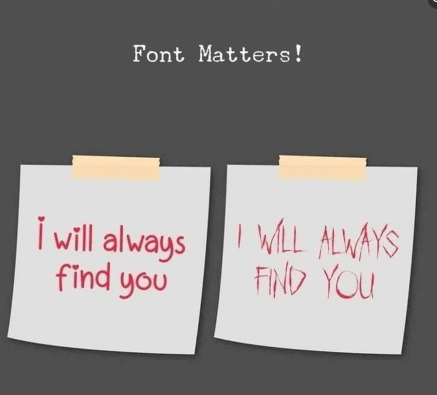
Second, a series of little sentences about grammar. I used to have my grammar hard-wired, having had both a great teacher in high school and a mom who was a sticker for grammar who went on to teach seventh grade language arts. (Have I ever told you how my mom packed her bags when I was a junior in high school and went back to college for a year to finish her degree so she could put her kids through college? She was an amazing woman.) Lately, I’ve come to believe that I must have a suffered a small stroke in the grammar center, as I’m constantly having to look things up.
An Oxford comma walks into a bar, where it spends the evening watching the television, getting drunk, and smoking cigars.
A dangling participle walks into a bar. Enjoying a cocktail and chatting with the bartender, the evening passes pleasantly.A bar was walked into by the passive voice.An oxymoron walked into a bar, and the silence was deafening.Two quotation marks walk into a “bar.”A malapropism walks into a bar, looking for all intensive purposes like a wolf in cheap clothing, muttering epitaphs and casting dispersions on his magnificent other, who takes him for granite.Hyperbole totally rips into this insane bar and absolutely destroys everything.A question mark walks into a bar?A non sequitur walks into a bar. In a strong wind, even turkeys can fly.Papyrus and Comic Sans walk into a bar. The bartender says, “Get out — we don’t serve your type.”A mixed metaphor walks into a bar, seeing the handwriting on the wall but hoping to nip it in the bud.A comma splice walks into a bar, it has a drink and then leaves.Three intransitive verbs walk into a bar. They sit. They converse. They depart.A synonym strolls into a tavern.At the end of the day, a cliché walks into a bar — fresh as a daisy, cute as a button, and sharp as a tack.A run-on sentence walks into a bar it starts flirting. With a cute little sentence fragment.Falling slowly, softly falling, the chiasmus collapses to the bar floor.A figure of speech literally walks into a bar and ends up getting figuratively hammered.An allusion walks into a bar, despite the fact that alcohol is its Achilles heel.The subjunctive would have walked into a bar, had it only known.A misplaced modifier walks into a bar owned by a man with a glass eye named Ralph.The past, present, and future walked into a bar. It was tense.A dyslexic walks into a bra.A verb walks into a bar, sees a beautiful noun, and suggests they conjugate. The noun declines.A simile walks into a bar, as parched as a desert.A gerund and an infinitive walk into a bar, drinking to forget.A hyphenated word and a non-hyphenated word walk into a bar and the bartender nearly chokes on the irony– Jill Thomas Doyle
And for all of you, but especially for my brother, John Clark, who cannot stop punning:
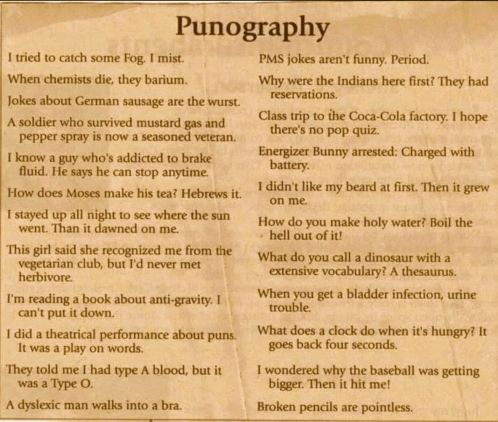
September 13, 2023
Pet Peeve of the Day
Kaitlyn Dunnett/Kathy Lynn Emerson here with a new pet peeve, one I didn’t even know I had.
Recently I started to read the first book in a new-to-me cozy mystery series. I had been looking forward to it because the premise was a bit unusual and was one that intrigued me. Before I finished the first chapter, however, I realized something was off. At first I couldn’t figure out what it was that kept pulling me out of the story. Then it hit me: the author consistently put modifiers in the wrong order.

I can see some of you scratching your heads. I probably would be too if I hadn’t remembered something I came across when I was doing research for the Deadly Edits series. It seemed like a good idea to refresh my memory about various grammar dos and don’ts if I was going to use a free-lance editor (aka “book doctor”) as my amateur detective. Among the “rules” I boned up on was one concerning the placement of multiple adjectives before a noun. The correct order is so ingrained in English speakers that we are largely unaware of it . . . except that it sounds wrong if we try to vary it.
The proper order is as follows: opinion, size, age, shape, color, origin, material, purpose.
Examples? Correct: That stupid old woman. Wrong (and doesn’t it just sound wrong?): That old stupid woman. Correct: The earth looks like a big blue marble. Wrong: The earth looks like a blue big marble.

Try it yourself. Come up with almost any list of adjectives and change the “correct” order and it’s going to sound awkward.
There are rare exceptions, like the big bad wolf. Strictly speaking bad, the opinion, should come before big, the size. But apparently there’s another grammar rule that covers this case, something called ablaut reduplication. I’m not even going to try to understand that one.
All this doesn’t explain why this particular author consistently altered the order of adjectives in her prose, but it does explain why doing so made her book unreadable for me. That’s a shame, too, because I still think her premise had promise.

Kathy Lynn Emerson/Kaitlyn Dunnett has had sixty-four books traditionally published and has self published others, including several children’s books. She won the Agatha Award and was an Anthony and Macavity finalist for best mystery nonfiction of 2008 for How to Write Killer Historical Mysteries and was an Agatha Award finalist in 2015 in the best mystery short story category. In 2023 she won the Lea Wait Award for “excellence and achievement” as a Maine writer from the Maine Writers and Publishers Alliance. She was the Malice Domestic Guest of Honor in 2014. She is currently working on creating new omnibus e-book editions of her backlist titles. She maintains websites at www.KaitlynDunnett.com and www.KathyLynnEmerson.com.
September 12, 2023
Fresh Start
Forget New Year’s Eve. Most of my life has been spent in classrooms on either side of the teacher’s desk and in school libraries. So it’s natural that I think of September as starting the year off. I’ve had so, so many first days of school. Alas, I haven’t bought any sharpened pencils or blindingly white sneakers or Trapper Keepers lately. But I’m choosing to look upon this month as a new beginning anyway.
I’ve been pretty slow with the writing lately. Not sure whether that’s the result of laziness or old age or sheer discouragement. Probably a combination of the three. Publishing remains a mystery (no pun intended) to me even after writing around 30 books and novellas.
My latest cozy mystery series has not yet found a home, despite very favorable responses from editors and the determined dedication of my agent. Basically, we’ve heard “I love it but I’m not going to buy it.” If the two completed books are ever going to get out into the wild, it looks as if I will have to self-publish them. Which I dread but will do. New beginnings, right?
I also opened myself up to a project as “a writer for hire.” The company supplied the storyline and characters, and I punched and pummeled it around. The ten-page sample is not going anywhere, but they liked the writing and other opportunities might follow. I am reminded of that ancient TV show, Have Gun-Will Travel. My aim might be off, but I’m still firing away.
And you might remember some months ago I enlisted your help in trying to decide what should come next. I finally decided. There is a Maine historical mystery in my future, something I’ve been fiddling with for absolute ages. Time to forge ahead instead of dubbing around, as my husband would say. It is informed by a four-year residence on a Maine island and working at the historical society there, and will be different from anything I’ve ever written. New beginnings, I say!
And now, a farewell to garden pleasures ending. Next spring, fingers crossed, we get to do it all over again. Fresh starts for all of us, another chance to grow.
Any tips for self-publishing? What’s in your garden?






Please visit www.maggierobinson.net for more info!
September 11, 2023
More Than A Shoe Part

… Well, this could be the last time
This could be the last time
Maybe the last time
I don’t know, oh no, oh no (Rolling Stones)
John Clark musing about the concept of When. After my third fall on the day before Labor Day (only my ego suffered), the most abysmal gardening year of my life, and assorted dark thoughts (non-lethal, but mostly humorous as hell), I’ve turned to pondering those ‘last times’ all of us will face, or maybe already have started to.
Some are part of the natural evolution of life. There was a time when I bowled ten pins three nights a week, but that lost its allure a long time ago. I still have uncounted gigabytes of computer role-playing games on my two computers, but while I think of them fondly, I hardly ever play, mostly because it’s more fun to create my own fantasy lands as a writer. The same goes for friends. I learned a long time ago that not everyone ages or matures at the same rate and I’ve outgrown people I was once very close to.
Then, there are ‘lasts’ beyond our control…places going out of business like the movie theater in Pittsfield and the drive-in in Skowhegan, or products we’ve bought and come to rely upon that have vanished from store shelves.
In my case, it seems like every birthday after a certain point that ends in zero changes my body chemistry to make eating something I’ve enjoyed all my life unpleasant. at fifty it was fried foods, at sixty spicy stuff (at least the upper ranges I used to consume with impunity). ant at seventy, I discovered I had a sudden intolerance for avocadoes.
I have a friend and a cousin who have sold their motorcycles because of the danger of dropping them, or getting hit while driving. Likewise two other friends have sold their boats and no longer fish. They cited the following reasons, danger of tipping and lack of fishing buddies. In a related scenario, a friend in Hartland volunteered that he’d quit hunting when he had to use his shotgun to help prop him up so he could walk home.

Most of the ‘lasts’ that come to mind involve physical activity, but not all. Consider the following: going to a concert-rude, rowdy crowds and poor hearing all come to mind as does the sad reality that many of the performers we grew up with are dropping like flies (I really miss Gordon Lightfoot), not to mention obscene ticket prices. Twenty-two years ago today (9/11) probably did it for many in terms of flying. We still do, but given a choice, I’d go by train. Then, there are pets. We have an old, nearly blind and deaf dog who we both love, but when he’s gone, that’s likely it. I’m tired of feeling like I’m a hostage to his weak bladder.
As for the physical stuff. I know climbing even a gentle mountain trail is behind me. We climbed Katahdin 47 years ago and I can still remember how long it took to stand up without wincing after we returned to camp. Flat, well-cleared trails are still doable, but wading on slippery rocks while fishing is out, as is getting into a kayak. The getting in is no problem, the reverse, however is likely a deal breaker. Canoeing is still possible as long as the two of us can get the sucker atop my car and fasten it securely.
As for gardening, given how much money we put into ours this year, not to mention the time and effort (mostly on Beth’s part) to keep it weeded, just so we could get a handful of tomatoes, celery, and a few meals of beans? Not likely to go there again.
‘Whens’ still on the go list include going to sporting events, eating out, plays, day trips, taking unusual photos, our week in Perry, going to book sales and then selling online (that NEVER gets old), discovering new books to read (don’t tell Beth, but I have 6 new ones on order at Bullmoose), cloud watching, and most important of all, coming up with new story ideas whether they are short ones or book length. I sat down last week to create something for a short story competition sponsored by a liquor company. The requirements were a it needed a ghost and had to be between 250-2000 words. I whipped up a nice rough draft of 1945 words in three hours. Once it set for a couple days, I submitted it. Will it win? No way of telling, but the last one I wrote for a similar contest ended up in King’s River Life.

Where are you on the ‘last’ spectrum?
September 8, 2023
Weekend Update: September 9-10, 2023
 Next week at Maine Crime Writers there will be a posts by John Clark (Monday), Maggie Robinson (Tuesday), Kaitlyn Dunnett/Kathy Lynn Emerson (Thursday), and Kate Flora (Friday).
Next week at Maine Crime Writers there will be a posts by John Clark (Monday), Maggie Robinson (Tuesday), Kaitlyn Dunnett/Kathy Lynn Emerson (Thursday), and Kate Flora (Friday).
In the news department, here’s what’s happening with some of us who blog regularly at Maine Crime Writers:
from Kaitkyn Dunnett/Kathy Lynn Emerson: I have another omnibus edition out, this one consisting of three romance novels previously published by Bantam’s Loveswept line in the late 1990s.

The Waycross Springs Trilogy features three stories set in Waycross Springs, Maine, a location that also appears in some of the Liss MacCrimmon mysteries and in The Valentine Veilleiux Mysteries. For more information, please go to http://www.kathylynnemerson.com/romance.htm Several familiar faces from Liss MacCrimmon’s world also turn up in these novels. Although it is available at all the usual online bookstores, here’s the Amazon link for convenience:
Our friends at the Topsham Library have asked us to share information about their annual writing competition. Check it out here:
Don’t forget our body contest. Time is running out and entries are rolling in. Will we have one from you?
It’s Maine Crime Writers “Where Would You Put the Body?” contest – late summer/early fall edition. How do you enter? Send a photograph of your chosen spot to: WritingAboutCrime@gmail.com with “Where Would You Put the Body?” in the subject line. There will be prizes for First, Second, and Third place–books of course and other Maine goodies. You may enter no more than three photographs, each one entered separately. They must be of Maine places and you must identify the place in your submission. Photos must be the submitter’s original work. Contest will run through the middle of October.
An invitation to readers of this blog: Do you have news relating to Maine, Crime, or Writing? We’d love to hear from you. Just comment below to share.
And a reminder: If your library, school, or organization is looking for a speaker, we are often available to talk about the writing process, research, where we get our ideas, and other mysteries of the business, along with the very popular “Making a Mystery” with audience participation, and “Casting Call: How We Staff Our Mysteries.” We also do programs on Zoom. Contact Kate Flora
Lea Wait's Blog
- Lea Wait's profile
- 509 followers



